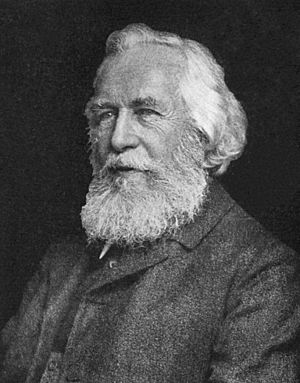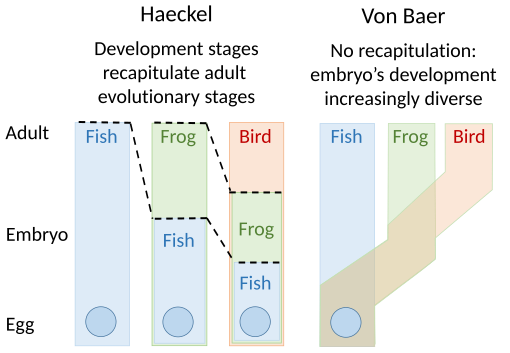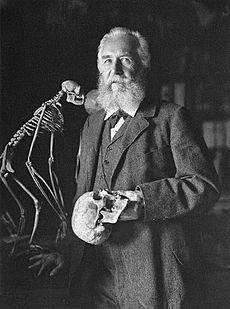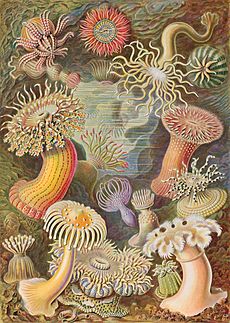Ernst Haeckel facts for kids
Quick facts for kids
Ernst Haeckel
|
|
|---|---|
 |
|
| Born |
Ernst Heinrich Philipp August Haeckel
16 February 1834 |
| Died | 9 August 1919 (aged 85) Jena, Germany
|
| Alma mater | |
| Known for | Recapitulation theory |
| Spouse(s) | Anna Sethe, Agnes Huschke |
| Awards |
|
| Scientific career | |
| Fields |
|
| Institutions | University of Jena |
| Influences | Jean-Baptiste Lamarck Johann Wolfgang von Goethe Charles Darwin August Schleicher |
| Author abbrev. (botany) | Haeckel |
| Author abbrev. (zoology) | Haeckel |
| Signature | |
Ernst Heinrich Philipp August Haeckel (1834–1919) was a German scientist, artist, and philosopher. He was a zoologist, naturalist, and marine biologist. Haeckel discovered and named thousands of new species. He also drew a "genealogical tree" showing how all life forms are related.
Haeckel created many important terms in biology, such as ecology, phylum, phylogeny, and Protista. He helped make Charles Darwin's ideas about evolution popular in Germany. Haeckel also developed a theory called recapitulation theory. This theory suggested that an organism's development (ontogeny) repeats its species' evolutionary history (phylogeny). However, this idea is not widely accepted today.
Haeckel's published artwork includes over 100 detailed, colorful illustrations of animals and sea creatures. These were collected in his book Kunstformen der Natur ("Art Forms of Nature"). This book later influenced the Art Nouveau art movement. As a philosopher, Haeckel wrote The Riddle of the Universe. He also wrote Freedom in Science and Teaching to support teaching evolution.
It is important to know that Haeckel also supported ideas like scientific racism and Social Darwinism. These ideas are harmful and not based on science. He was also the first person to call World War I the "first" World War in 1914.
Contents
Early Life and Education
Ernst Haeckel was born on February 16, 1834, in Potsdam, which was then part of Prussia. In 1852, he finished high school. He then went on to study medicine in Berlin and Würzburg. He learned from famous scientists like Johannes Peter Müller.
In 1857, Haeckel earned his medical degree. However, he found that being a doctor was not what he wanted to do. He preferred studying nature.
A Career in Science
Haeckel studied with Karl Gegenbaur at the University of Jena for three years. In 1861, he became a professor of comparative anatomy. He then became a professor of zoology at the University of Jena in 1862. He stayed there for 47 years, until 1909.
Between 1859 and 1866, Haeckel studied many different types of animals. These included radiolarians, poriferans (sponges), and annelids (segmented worms). During a trip to the Mediterranean Sea, he named almost 150 new species of radiolarians.
In 1864, his first wife, Anna Sethe, passed away. Haeckel named some beautiful jellyfish species after her, like Desmonema annasethe.
From 1866 to 1867, Haeckel traveled to the Canary Islands. He also visited London and met Charles Lyell and Thomas Henry Huxley. On October 21, 1866, he visited Charles Darwin at his home. In 1867, Haeckel married Agnes Huschke. They had three children: Walter, Elizabeth, and Emma.
Haeckel continued his travels, going to Norway in 1869 and Croatia in 1871. In 1873, he visited Egypt, Turkey, and Greece. In 1907, he had a museum built in Jena. This museum, the Jena Phyletisches Museum, was designed to teach people about evolution. Haeckel retired from teaching in 1909. He passed away on August 9, 1919.
What Was Haeckel's Research About?
Haeckel was a zoologist and a talented artist. He was known for his detailed illustrations. He was also a professor of comparative anatomy. Haeckel's ideas were important for the history of evolutionary theory. He was especially famous for his work on radiolaria, which are tiny sea creatures.
However, some of Haeckel's ideas are now considered incorrect. For example, he described some imaginary ancient microorganisms that have never been found. He also proposed the kingdom Protista in 1866. His main interests were evolution and how life develops. This led to his beautifully illustrated book, Kunstformen der Natur (Art forms of nature).
Embryology and Recapitulation Theory

Haeckel is well known for his "recapitulation theory." He summed it up with the phrase "ontogeny recapitulates phylogeny." This meant he believed that the development of an individual organism (ontogeny) repeats the evolutionary stages of its species (phylogeny). For example, he thought that a human embryo briefly looked like a fish, then a reptile, and so on.
However, this strong version of his theory has been disproven. Scientists now follow the ideas of Karl Ernst von Baer. Von Baer's laws state that embryos of different species start similar but then develop differently. They do not repeat the adult forms of other species.
Haeckel used embryo drawings to support his theory. These drawings have since been shown to be too simple and not fully accurate. While comparing embryos is still important for showing how animals are related, Haeckel's specific theory is an oversimplification.
Searching for Human Ancestors
Haeckel was a very bold thinker. He sometimes made big guesses without enough scientific proof. For example, after Darwin's book On the Origin of Species came out, Haeckel predicted where human ancestors would be found. He thought they would be in the Dutch East Indies (now Indonesia).
He even described these unknown ancestors in detail and named them Pithecanthropus alalus. He encouraged his students to go find them. One of his students, Eugène Dubois, did find some remains in 1891. These were called Java Man and included a skullcap and thighbone. They were later reclassified as Homo erectus.
While Java Man was an important discovery, scientists now believe that the direct ancestors of modern humans came from Africa.
Views on Human Races
Haeckel had ideas about human races that are now seen as harmful and incorrect. He believed that different human groups had evolved separately. He also thought that some races were "higher" or more developed than others. For example, he claimed that "Negroes" were less evolved than "Whites." He even compared them to "four-handed" apes.
These ideas are called scientific racism. They are not supported by modern science. Many historians believe that Haeckel's ideas contributed to later harmful movements, including some aspects of Nazism. However, it is also noted that Haeckel himself was not anti-Semitic and sometimes formed close relationships with native people during his travels.
Haeckel also believed that the first humans came from Asia. He thought the missing link in human evolution might be found on a lost continent called Lemuria in the Indian Ocean. He believed Lemuria connected Asia and Africa, allowing humans to spread across the world.
Religious Views
Haeckel was a supporter of monism. This is a philosophical idea that says everything in the universe is made of one basic substance or principle. In his book Monism as Connecting Religion and Science (1892), he argued that monism fit well with scientific understanding. His view of monism was pantheistic, meaning he saw God as being in everything, rather than a separate being.
Awards and Recognition
Haeckel received many honors for his scientific work. He was elected to the American Philosophical Society in 1885. In 1907, he was given the title of Excellency by Kaiser Wilhelm II. He also received the prestigious Darwin–Wallace Medal in 1908.
Several places and things are named after him:
- Mount Haeckel, a mountain in the Sierra Nevada in the United States.
- Another Mount Haeckel in New Zealand.
- The asteroid 12323 Haeckel.
- The ratfish, Harriotta haeckeli.
- The research vessel Ernst Haeckel.
- The botanical journal Ernstia.
- The genus of calcareous sponges called Ernstia.
In Jena, where he worked for many years, there is a monument to him. The Jena Phyletic Museum continues to teach about evolution and share his work.
Images for kids
-
Haeckel's tree of life
See also
 In Spanish: Ernst Haeckel para niños
In Spanish: Ernst Haeckel para niños









